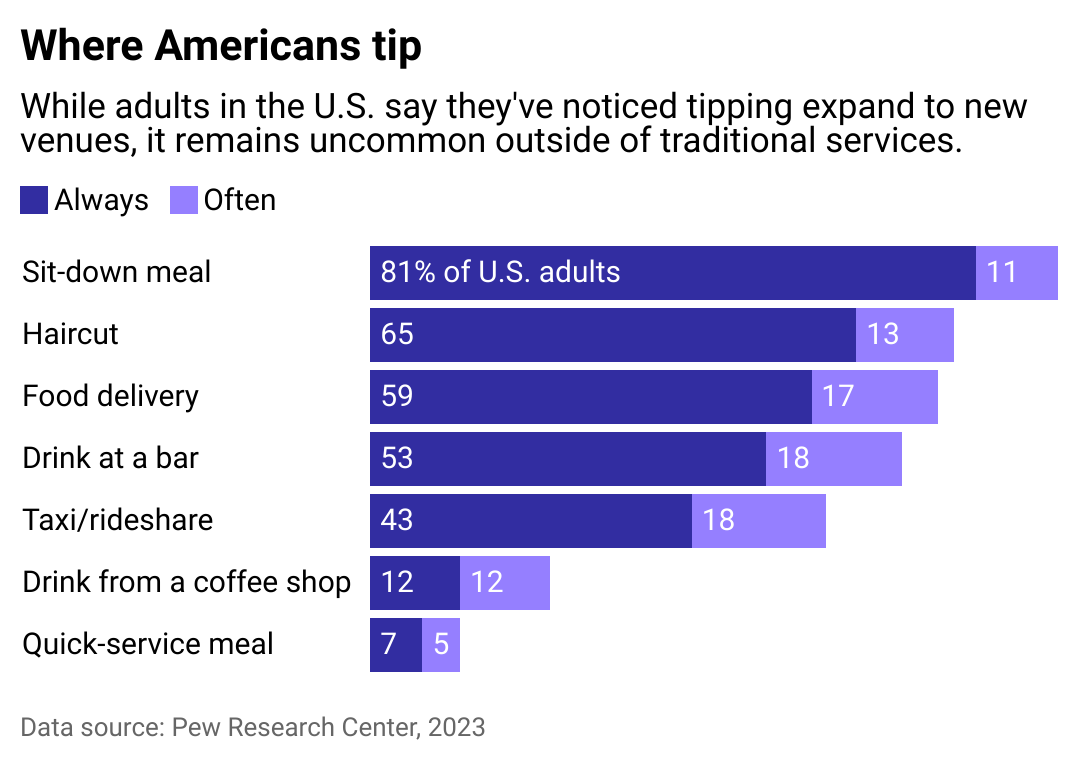Changing tipping culture has Americans befuddled: Does everything require a tip?
Sadi-Santos // Shutterstock
Changing tipping culture has Americans befuddled: Does everything require a tip?
Man holding a tablet with tipping screen inside a restaurant.
Tipflation is upon us.
The COVID-19-era explosion of cashless points of sale and touchscreens in shops, cafes, auto repair shops, and anywhere else money is exchanged has sent tipping culture into a tizzy: People are even prompted to tip upon checkout at retail shops and merch booths at farmers’ markets.
Approximately 72% of American adults noted that tips are being expected in more places presently than they were five years prior, according to a Pew Research Center survey conducted in August 2023. This tipflation, or “tip creep,” allows businesses to nudge customers for tips while keeping employee compensation low and exacerbating customers. Uniqode used data from Pew Research Center and news reports to explore how technology is changing the tipping culture in the U.S.
The expansion of tipping expectations has contributed to confusion and “tip fatigue,” where customers feel pressured and frustrated when asked for tips in nontraditional places. The Pew survey, for example, found that only about one-third of Americans found it very easy to know when was an appropriate time to tip.
At the height of the COVID-19 pandemic, when lockdown restrictions prohibited dining in, customers tipped delivery workers and cashiers at take-out restaurants to support their work as essential workers. But as Americans returned to business as usual, the new standard for tipping remained.
Rising inflation has made tips more essential to overall compensation for workers with low hourly wages. Pressuring customers to tip also helps employers retain workers in a competitive market—even if it’s adding to the anxiety of patrons.
![]()

Uniqode
While we’re encouraged to tip in more venues, our habits haven’t changed much
Bar chart showing where Americans tip. Sit-down meals and haircuts are the most prevalent, while not so many people leave tips at coffee shops and quick-service restaurants.
Technology—particularly cashless payment systems—may have upended tipping norms through a phenomenon known as the framing effect, a cognitive bias in which people make choices based on how a set of options is presented or “framed” instead of based on facts.
If a kiosk or other tech-based payment system prompts people to select 20%, 25%, and 28% tips instead of the traditional 10%, 15%, and 20%, it can create a culture of overtipping. It can also play into people’s desire not to appear ungenerous by nudging them to tip more. This tactic can also be done without technology, as restaurants can place higher percentages on receipts in their suggested tips sections.
Payment processing companies, which take a cut from every transaction, benefit from bigger tips. Cashless payment systems like Venmo, Cashapp, and Zelle allow people to pay buskers and street artists quickly, making paying tips more convenient. Some hotels use technologies that allow customers to pay tips by scanning a QR code.
While our overall tipping behaviors might not have changed entirely, the visualization above does underscore some movement. While many coffee shops historically had tip jars out for baristas, tipping at fast food restaurants or other quick-service locations wasn’t a regular part of American tipping culture. The fact that 12% of people now report tipping often or always in those settings shows how much has evolved in a short time—and how tipping may continue to adapt as the technology around us advances.
Story editing by Nicole Caldwell. Copy editing by Kristen Wegrzyn.
This story originally appeared on Uniqode (Beaconstac) and was produced and
distributed in partnership with Stacker Studio.
